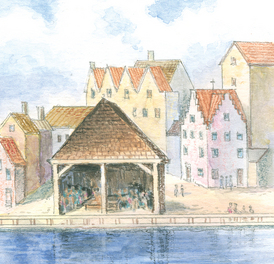by PETER ALAN HARPER
 “The Slave Market, located where Wall Street reached the East River, was established in 1711 as a place where enslaved blacks and Native Americans could be hired or purchased.” PHOTO/Columbia University
“The Slave Market, located where Wall Street reached the East River, was established in 1711 as a place where enslaved blacks and Native Americans could be hired or purchased.” PHOTO/Columbia University
The next time some right-wing commentator (Pat Buchanan, are you listening?) bellows about how white people built America, a tour of New York City could be used to point out how the slave trade (i.e., the labor of enslaved Africans) contributed to the creation of this country’s financial center.
The very name “Wall Street” is born of slavery, with enslaved Africans building a wall in 1653 to protect Dutch settlers from Indian raids. This walkway and wooden fence, made up of pointed logs and running river to river, later was known as Wall Street, the home of world finance. Enslaved and free Africans were largely responsible for the construction of the early city, first by clearing land, then by building a fort, mills, bridges, stone houses, the first city hall, the docks, the city prison, Dutch and English churches, the city hospital and Fraunces Tavern. At the corner of Wall Street and Broadway, they helped erect Trinity Church.
In 1711 the city’s Common Council established a Meal Market at Wall and Water streets for hiring slave labor and auctioning enslaved Africans who disembarked in Manhattan after their arduous trans-Atlantic journey. The merchants used these laborers to operate the port and in such trades as ship carpentry and printing, according to the National Park Service. Africans, according to the Park Service, also engaged in heavy transport, construction work, domestic labor, farming and milling. Their efforts were part of the euphemistically titled Triangular Trade: Africans living on what was then called the Gold Coast — with Africans being considered black gold — were bought using New England rum; the Africans were sold in the West Indies to work the fields to create sugar and molasses; and the sugarcane products were taken to New York and New England to be made into rum.
Pier 17 on the East River was a disembarkation point, as were all other slips and docks along lower Manhattan where the Hudson and East rivers rippled by. Today the pier is known as the South Street Seaport, a popular destination for gift-buying tourists who just happen to be visiting where enslaved Africans first touched land in chains.
The history of the area is described in Complicity: How the North Promoted, Prolonged, and Profited From Slavery — a book that details how deeply the slave trade was entrenched in America’s economy — by veteran newspaper journalists Anne Farrow, Joel Lang and Jenifer Frank. The authors wrote: “From 1825 on, in volume and value of imports and exports, the seaport of South Street outdid the combined trade of its two closest competitors in Boston and Philadelphia … long before civil war loomed, New York, after London and Paris, had become the third major city of the western world. Its glory was built largely of bricks of cotton,” the product of backbreaking labor.
The Root for more